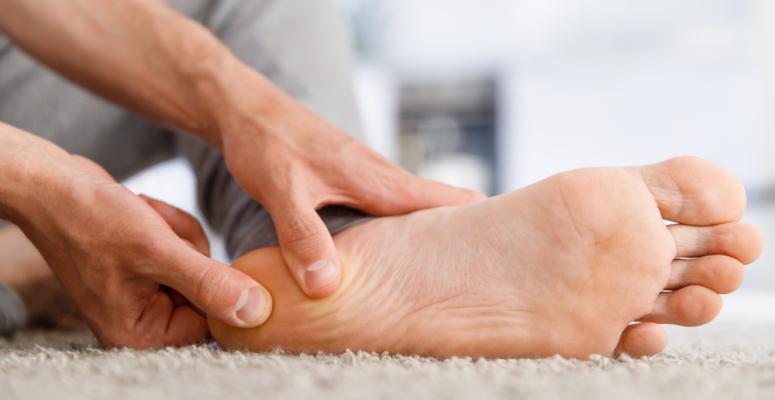
About <a href="https://www.nccih.nih.gov/research/research-results/analysis-of-data-on….">1%</a> of U.S. adults reported being diagnosed with plantar fasciitis within the last year. Meanwhile, about <a href="https://www.aafp.org/pubs/afp/issues/2002/0501/p1805.html">10%</a> of runners are diagnosed with Achilles tendinitis.<span class="Apple-converted-space"> </span>
These two conditions are two of the <a href="https://www.ncbi.nlm.nih.gov/pmc/articles/PMC7205976/">most common injuries</a> in the foot. They can both cause inflammation close to the heel bone, resulting in pain felt in the same general area. As a result, it can be difficult to differentiate between the two conditions on your own, especially since both can cause symptoms like:<span class="Apple-converted-space"> </span>
<ul>
<li><a href="/3-pt-methods-that-may-help-reverse-the-loss-or-absence-of-mobility-in-a-joint/">Stiffness</a> in the ankle and foot.<span class="Apple-converted-space"> </span></li>
<li>Swelling.<span class="Apple-converted-space"> </span></li>
<li>Redness.<span class="Apple-converted-space"> </span></li>
<li>Sharp pain when walking<span class="Apple-converted-space"> </span></li>
</ul>
Despite their similarities, plantar fasciitis and Achilles tendinitis are caused by different events, affect <a href="/have-osteoporosis-in-your-foot-here-are-3-ways-physical-therapy-may-help/">different types of tissue</a>, and are treated differently in medical and physical therapy settings. Knowing the differences between them can help you pursue the treatment you need for your <a href="/how-likely-are-you-to-develop-foot-pain-after-pregnancy/">ankle and heel pain</a>.<span class="Apple-converted-space"> </span>
<h2><b>What is plantar fasciitis?<span class="Apple-converted-space"> </span></b></h2>
Studies show that <a href="https://www.ncbi.nlm.nih.gov/pmc/articles/PMC3687890/">1 in 10</a> people will develop plantar fasciitis at least once in their lifetime. Since it is a common condition, it can be important to know its symptoms and how to differentiate it from other foot conditions. <span class="Apple-converted-space"> </span>
<a href="https://www.hopkinsmedicine.org/health/conditions-and-diseases/plantar-…">Plantar fasciitis</a> refers to when the tissue that runs along the bottom of your foot is inflamed. The ligament, also called the <a href="https://www.footvitals.com/health/anatomy/plantar-fascia.html">plantar fascia</a>, connects your heel bone to your joint. When damaged, it can cause pain and swelling. Overuse and long-term inactivity can cause plantar fasciitis, and it is usually felt as heel pain. Symptoms can include:<span class="Apple-converted-space"> </span>
<ul>
<li>Pain that worsens in the morning or after being inactive, and improves throughout the day.<span class="Apple-converted-space"> </span></li>
<li>Pain that feels concentrated at the bottom of the foot and heel.</li>
<li>Pain that worsens while walking in bare feet.</li>
</ul>
One of the clearest symptoms of plantar fasciitis is sharp pain that peaks in the morning after the foot has rested for long periods of time. This sharp pain occurs because the <a href="/why-would-your-podiatrist-send-you-to-physical-therapy-for-plantar-fasciitis/">plantar fascia ligament tightens</a> while you’re asleep, leading to intense stiffness and pain when you try to walk in the morning. This symptom is very common among those with plantar fasciitis and can help you rule out other foot conditions like Achilles tendinitis.<span class="Apple-converted-space"> </span>
Unfortunately, plantar fasciitis symptoms can lead to <a href="https://steptohealth.com/how-long-does-plantar-fasciitis-last/">months</a> of discomfort and can even become chronic. The misalignment caused by plantar fasciitis can even lead to other issues, like <a href="/can-plantar-fasciitis-cause-knee-pain-and-what-do-i-do-about-it/">knee and hip pain</a>. Sometimes, plantar fasciitis symptoms can be so unbearable that surgery is recommended.<span class="Apple-converted-space"> </span>
You can be at a higher risk of developing plantar fasciitis if you have flat feet, high arches, or spend most of your day on your feet.<span class="Apple-converted-space"> </span>
<h2><b>What is Achilles tendinitis?<span class="Apple-converted-space"> </span></b></h2>
Did you know that your Achilles tendon is the thickest and strongest tendon in your body? It can even handle up to <a href="https://www.nature.com/articles/s41598-019-49063-7">4 times</a> your body weight while walking. However, just because this tendon is strong doesn’t mean it can’t be injured. In fact, the Achilles tendon is frequently overstretched. About <a href="https://www.ncbi.nlm.nih.gov/pmc/articles/PMC4187594/%23:~:text=During%….">50%</a> of all sports-related injuries are due to tearing or stretching the Achilles tendon.
The tendon’s main role is to lift your heel from the floor while walking, running, climbing, or standing on your tiptoes. Achilles tendinitis can occur when the Achilles tendon is strained or torn. Hard falls, twists, stops, and starts can injure and inflame the tendon. The Achilles tendon can also tear over time if you neglect to <a href="/3-pt-methods-that-may-help-reverse-the-loss-or-absence-of-mobility-in-a-joint/">stretch</a> before performing high-intensity activities.<span class="Apple-converted-space"> </span>
Plantar fasciitis and Achilles tendinitis can differ in pain location. While plantar fasciitis is often felt at the bottom of the heel, Achilles tendinitis pain is often felt in the back of the heel. In addition, while plantar fasciitis is worse in the morning and improves throughout the day, Achilles tendinitis pain worsens with movement.<span class="Apple-converted-space"> </span>
Symptoms of Achilles tendinitis can include:
<ul>
<li>Swelling.<span class="Apple-converted-space"> </span></li>
<li>Bruising.</li>
<li>Pain when walking up inclines or stairs.</li>
<li>A hard bump near the tendon.<span class="Apple-converted-space"> </span></li>
</ul>
Left untreated, you can develop <a href="https://www.ncbi.nlm.nih.gov/pmc/articles/PMC5344857/">chronic Achilles tendinopathy</a>, or chronic Achilles tendinitis. This can cause permanent damage to your heel and ankle. Chronic Achilles tendinopathy is most often found in athletes.
<h2><b>How can you treat plantar fasciitis and Achilles tendinitis?</b></h2>
While different, plantar fasciitis and Achilles tendinitis can be treated in similar ways. The following treatments can help relieve your foot pain whether you have either condition:
<ul>
<li><a href="/what-is-functional-manual-therapy-and-how-can-it-help-with-injury-recovery/">Physical therapy</a>.<span class="Apple-converted-space"> </span></li>
<li>Orthotics.<span class="Apple-converted-space"> </span></li>
<li>Splints or walking boots. <span class="Apple-converted-space"> </span></li>
</ul>
<h2><b>Alliance PTP is ready to help you find top-notch PT for plantar fasciitis and Achilles tendinitis</b></h2>
Do you need help determining whether you have plantar fasciitis or Achilles tendinitis? At Alliance Physical Therapy Partners, we’re proudly bringing together physical therapy practices across the country to help people get the high-quality PT they need. Want to see a physical therapist in person? We can put you in touch with an Alliance PTP partner that’s <a href="/locations/">close to you</a> and that can help you address Achilles tendinitis and plantar fasciitis.<span class="Apple-converted-space"> </span>
Not keen on in-person PT sessions or not close to an Alliance PTP partner? No worries. We also offer effective and affordable virtual physical therapy through our <a href="/agile-virtual-pt/">Agile Virtual Physical Therapy</a> platform.<span class="Apple-converted-space"> </span>
<a href="/contact/">Contact our team</a> today so we can help you find the most effective physical therapy services for your injury.<span class="Apple-converted-space"> </span>
Get Help at a Location Near You
